From Truckin’ Life February 2014
The most direct route from the Kimberley to central Australia is the Tanami Track.
About 800 kilometres of this important arterial road is gravel and dirt.
A Kimberley shire has a radical proposal to make it a toll way, charging road trains up to $2,000 to use it, so funds would be available to seal the road.
I explained how this would then open up a major trade route to south-eastern Australia.
A local WA shire is sponsoring a radical new proposal. Halls Creek shire wants to charge road trains $1,000 to use Australia’s first outback tollway. The money would be used fund the Tanami Track’s upgrade, sealing and maintenance. There are no plans to charge a toll for vehicles other than trucks.
The road from Halls Creek, in WA’s Kimberley region, to Alice Springs measures 1077km and includes about 800 kilometres of dirt. Besides being the only supply line for a dozen or so stations, mines and Aboriginal communities, it is the most direct route connecting the Kimberley with central Australia. Advocates say the alternative route, via Kununurra and Katherine, takes an extra 1100 kilometres, or 17 hours’ driving and $4,500 running costs.
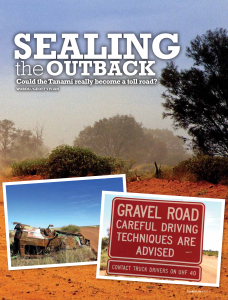 Upgrading the road, they say, would open up a large amount of trade between the Kimberley and south-eastern Australia. Currently, the Kimberley is mostly supplied from Perth. Not much of the region’s produce gets to Australia’s south-east, despite the fact that Halls Creek is closer to Adelaide than Perth. Mines near the WA-NT border could be supplied with fuel via Wyndham port and the Great Northern Highway, rather than a circuitous route from Darwin via Alice Springs, using rail and road.
Upgrading the road, they say, would open up a large amount of trade between the Kimberley and south-eastern Australia. Currently, the Kimberley is mostly supplied from Perth. Not much of the region’s produce gets to Australia’s south-east, despite the fact that Halls Creek is closer to Adelaide than Perth. Mines near the WA-NT border could be supplied with fuel via Wyndham port and the Great Northern Highway, rather than a circuitous route from Darwin via Alice Springs, using rail and road.
The northern section, an old mission road, has many jump ups, creek crossings and hairpin bends. On the Territory side, sections of the road are often closed in the wet season. Many operators refuse to touch it. Others charge a premium to cover the additional costs.
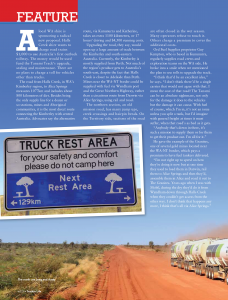 Ord Fuel Supplies proprietor Guy Kempton, who is based in Kununurra, regularly supplies road crews and exploration teams on the WA side. He broke into a smile when we mentioned the plan to use tolls to upgrade the track.
Ord Fuel Supplies proprietor Guy Kempton, who is based in Kununurra, regularly supplies road crews and exploration teams on the WA side. He broke into a smile when we mentioned the plan to use tolls to upgrade the track.
“I think that’d be an excellent idea,” he says. “I don’t think there’d be a single carrier that would not agree with that. I mean the cost of that road! The Tanami can be an absolute nightmare, not only for the damage it does to the vehicles but the damage it can cause. With fuel of course, which I’m in, it’s not an issue unless you split a tank, but I’d imagine with general freight at times it must suffer, when that road’s as bad as it gets.
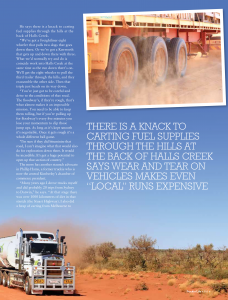 “Anybody that’s down in there, it’s such a mission to supply them or for them to get their product out. I’m all for it.”
“Anybody that’s down in there, it’s such a mission to supply them or for them to get their product out. I’m all for it.”
He gave the example of the Granites, one of several gold mines located near the WA-NT border, which pays a premium to have fuel tankers delivered.
“I’m not right up to speed on how they’re doing it now but at one time they used to load them in Darwin, rail them to Alice Springs and then they’d, assemble them in Alice and road it out to The Granites. Years ago when I was with Mobil, during the dry they’d do it from Wyndham down through Halls Creek when they couldn’t get access from the other way. I don’t think that happens any more, I think that’s all via Alice Springs.”
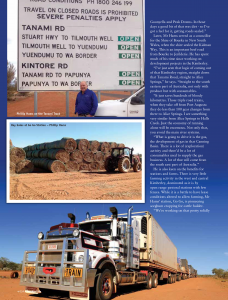 He says there is a knack to carting fuel supplies through the hills at the back of Halls Creek.
He says there is a knack to carting fuel supplies through the hills at the back of Halls Creek.
“We’ve got a Freightliner eight wheeler that pulls two dogs that goes down there. Or we’ve got a Kenworth that gets up and down there with three. What we’d normally try and do is coincide work into Halls Creek at the same time as the run down there’s on. We’ll get the eight wheeler to pull the third trailer through the hills, and they reassemble the other side. Then that triple just heads on its way down.
“You’ve just got to be careful and drive to the conditions of that road. The floodways, if they’re rough, that’s what almost makes it an impossible mission. You need to be able to keep them rolling, but if you’re pulling up for floodways every five minutes you lose your momentum to clip those jump ups. As long as it’s kept smooth it’s negotiable. Once it gets rough it’s a whole different ball game.
“I’m sure if they did bituminise that road, I can’t imagine what that would also do for exploration down there. It would be incredible. It’s got a huge potential to open up that section of country.”
The move has another staunch advocate in Phillip Hams, a former truckie who is now the central Kimberley’s chamber of commerce president.
“Many years ago I drove trucks myself and did probably 20 trips from Sydney to Darwin,” he says. “At that stage there was over 1000 kilometres of dirt in that stretch (the Stuart Highway). I also did a heap of carting from Melbourne to Goonyella and Peak Downs. In those days a good bit of that was dirt – so I’ve got a feel for it, getting roads sealed.”
Later, Mr Hams served as a councillor for the Shire of Bourke in New South Wales, when the shire sealed the Kidman Way. This is an important beef road from Bourke to Jerilderie. He has spent much of his time since working on development projects in the Kimberley.
“I’ve just seen that logic of coming out of that Kimberley region, straight down that Tanami Road, straight to Alice Springs,” he says. “Straight to the south eastern part of Australia, not only with produce but with consumables.
“It just saves hundreds of bloody kilometres. Those triple road trains, when they take off from Port Augusta they do less than 100 gear changes from there to Alice Springs. I see something very similar from Alice Springs to Halls Creek. Just the economy of running alone will be enormous. Not only that, you avoid the main river systems.
“What is going to drive it is the gas, the development of gas in that Canning Basin. There is a lot of (exploration) activity and there’d be a lot of consumables used to supply the gas business. A lot of that will come from the south east part of Australia.”
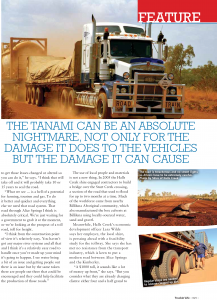 He is also keen on the benefits for stations and farms. There is very little farming activity in the west and central Kimberley, dominated as it is by open range pastoral stations with few fences. While it is a battle to have lease conditions altered to allow farming, Mr Hams’ station, Go Go, is pioneering sorghum cropping for cattle fodder.
He is also keen on the benefits for stations and farms. There is very little farming activity in the west and central Kimberley, dominated as it is by open range pastoral stations with few fences. While it is a battle to have lease conditions altered to allow farming, Mr Hams’ station, Go Go, is pioneering sorghum cropping for cattle fodder.
“We’re working on that pretty solidly to get those leases changed or altered so you can do it,” he says. “I think that will take off and it will probably take 10 or 15 years to seal the road.
“What we see … is a hell of a potential for farming, tourism and gas. To do it better and quicker and everything else we need that road system. That road through Alice Springs I think is absolutely critical. We’re just waiting for a government to grab it at the moment, or we’re looking at the prospect of a toll road, toll for freight.
“I think from the construction point of view it’s relatively easy. You haven’t got any major river systems and all that and I think it’s a relatively easy road to handle once you’ve made up your mind it’s going to happen. I see water being a bit of an issue and getting people out there is an issue but by the same token there are people out there that could be encouraged and they could help facilitate the production of those roads.”
The use of local people and materials is not a new thing. In 2005 the Halls Creek shire engaged contractors to build a bridge over the Sturt Creek crossing, a section of the road that used to flood for up to two months at a time. Much of the workforce came from nearby Billiluna Aboriginal community, which also manufactured the box culverts at Billiluna using locally-sourced water, sand and gravel.
Meanwhile, Halls Creek’s economic development officer Lara Wilde says her employer, the local shire, is pressing ahead with a feasibility study for the tollway. She says she has met no resistance from the transport industry, which is keen to put a modern road between Alice Springs and the Kimberley.
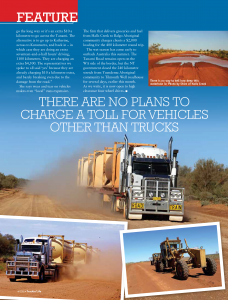 “A $1000 toll, it sounds like a lot of money up front,” she says. “But you consider what they are already charging clients: either four and a half grand to go the long way or it’s an extra $10 a kilometre to go across the Tanami. The alternative is to go up to Katherine, across to Kununurra, and back in – in which case they are doing an extra seventeen-and-a-half hours’ driving, 1100 kilometres. They are charging an extra $4,500. The representatives we spoke to all said ‘yes’ because they are already charging $10 a kilometre extra, and barely breaking even due to the damage from the road.”
“A $1000 toll, it sounds like a lot of money up front,” she says. “But you consider what they are already charging clients: either four and a half grand to go the long way or it’s an extra $10 a kilometre to go across the Tanami. The alternative is to go up to Katherine, across to Kununurra, and back in – in which case they are doing an extra seventeen-and-a-half hours’ driving, 1100 kilometres. They are charging an extra $4,500. The representatives we spoke to all said ‘yes’ because they are already charging $10 a kilometre extra, and barely breaking even due to the damage from the road.”
She says wear and tear on vehicles makes even “local” runs expensive. The firm that delivers groceries and fuel from Halls Creek to Balgo Aboriginal community charges clients a $2,000 loading for the 400 kilometre round trip.
The wet season has come early to outback Australia this summer. The Tanami Road remains open on the WA side of the border, but the NT government closed the 240 kilometre stretch from Yuendemu Aboriginal community to Tilmouth Well roadhouse for several days, earlier this month. As we write, it is now open to high clearance four wheel drives.
(c) 2014 Truckin’ Life
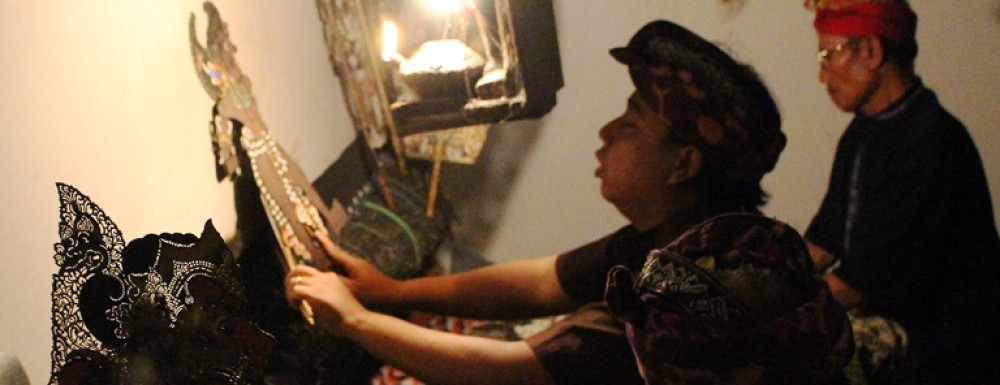
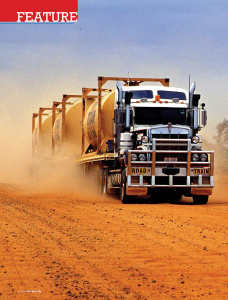
Visionary legends whom have had the Kimberley’s interest at heart include the Texan Jack Fletcher (Liveringa/camballon ALCO Cattle development), the late and great Mr Ernie Bridge MLA, John Henwood (Fossil Downs),Phillip Hams of GoGo Station at Fitzroy Crossing and Goondiyandi elder Jimmy Shandley.
All practical and lateral thinking, well grounded visionaries and leaders in their own right whom have the indigenous interests at the forefront of development. When will we ever have politicians with similar views, passion, commitment and common sense??? Maybe not in my lifetime … Regretfully.